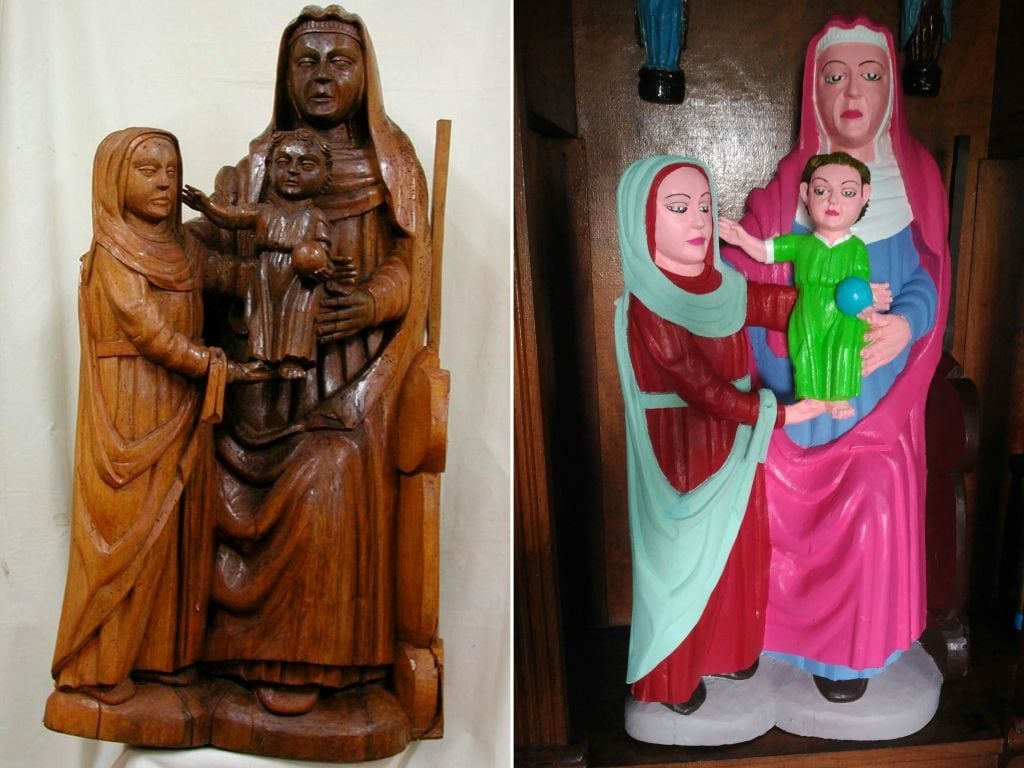Art World
‘The Statues Really Needed Painting’: An Amateur Artist Defends Her Neon ‘Restoration’ of a 15th-Century Religious Shrine
Mary's makeover includes lipstick, eyeliner, and green hair.

Mary's makeover includes lipstick, eyeliner, and green hair.

Kate Brown

There’s been another sacrilegious restoration in the land of “Beast Jesus.”
The most recent “restoration” plunder in Spain has taken place in the northwestern region of Asturias, in the village of Rañadorio. A local tobacco shop owner, María Luisa Menéndez, has brightly repainted a 15th-century sculptural trinity of Mary, Saint Anne, and baby Jesus, as well as two other figures—one of Saint Peter and a second Virgin Mary.
Menéndez gave the wooden figures a neon makeover, including fresh eyeliner and lipstick. The amateur painter has defended her decision, saying that the statues in the shrine needed a paint job. She said that she had received permission from the local clergy, according to local media reports.
“I’m not a professional painter but I’ve always liked painting and the statues really needed painting,” she told El Comercio. “I painted them as best I could using what I thought were the right colors. The neighbors liked them too. Ask around here and you’ll find out.”
Apparently local news outlets did find some supportive locals (the town has 16 residents). But Genaro Alonso, the regional minister for culture and education in Asturias, disagrees. He called the amateur work more “a vengeance than a restoration,” according to the newspaper La Voz de Asturias.

Several Romanesque period religious statues displayed at the church of El Ranadoiro, close to Cangas del Narcea in Asturias region, after being “restored” by a local woman. Photo: DSF/AFP/Getty Images.
In fact, the statues had been restored by a professional only 15 years earlier. The reason that restorer had left the trinity piece of Mary, Saint Anne, and baby Jesus unpainted was because the wooden family had never been painted in the first place.
“They’ve used the kind of industrial enamel paint they sell for painting anything and absolutely garish and absurd colors,” Luis Suárez Saro, the original restorer, told the Guardian. “The result is just staggering. You don’t know whether to laugh or cry.”
Saro says an infrared examination will need to be undertaken in order to determine the damage and whether any of the original polychrome paint on Saint Peter and the Virgin Mary statute had survived.
This isn’t the first time that Spain has had amateur restoration attempts on its historical art. In June, a Spanish art teacher tried to restore went to the Church of San Miguel de Estella in Navarre, Spain, to try to restore a 16th-century Saint George on horseback, giving him a cartoonish makeover that drew comparisons to Hergé’s comic book character Tintin. Then there was the Ecce Homo incident of 2012, in which 83-year-old Cecilia Giménez painted over an almost century-old fresco of Jesus in her local church in Borja, Spain. The monkey-like results earned the now-infamous moniker “Beast Jesus.”
Many in Spain have taken to Twitter with the hashtag #SOSPatrimonio (#SOSPatrimony), demanding an intervention into the trend that they view as an attack on their heritage.
De nuevo gritamos #SOSPatrimonio. ¿A nadie le importa este expolio continuado en nuestro país? ¿Qué tipo de sociedad permite pasiva que destruyan ante sus ojos el legado de sus antepasados? https://t.co/iCEqmxtvDc pic.twitter.com/PhW7BGfZGc
— ACRE (@A_CR_E) September 6, 2018